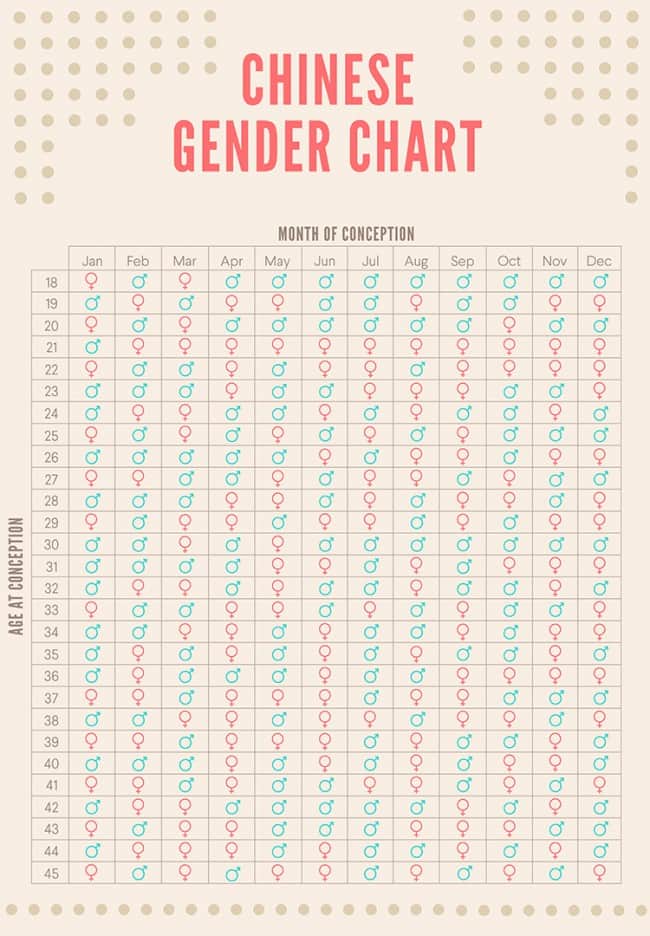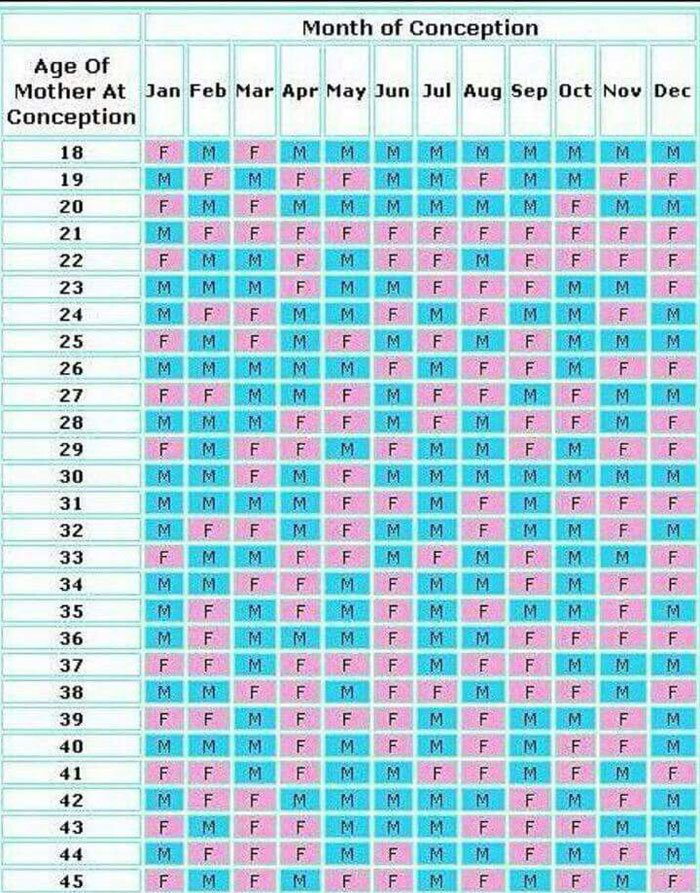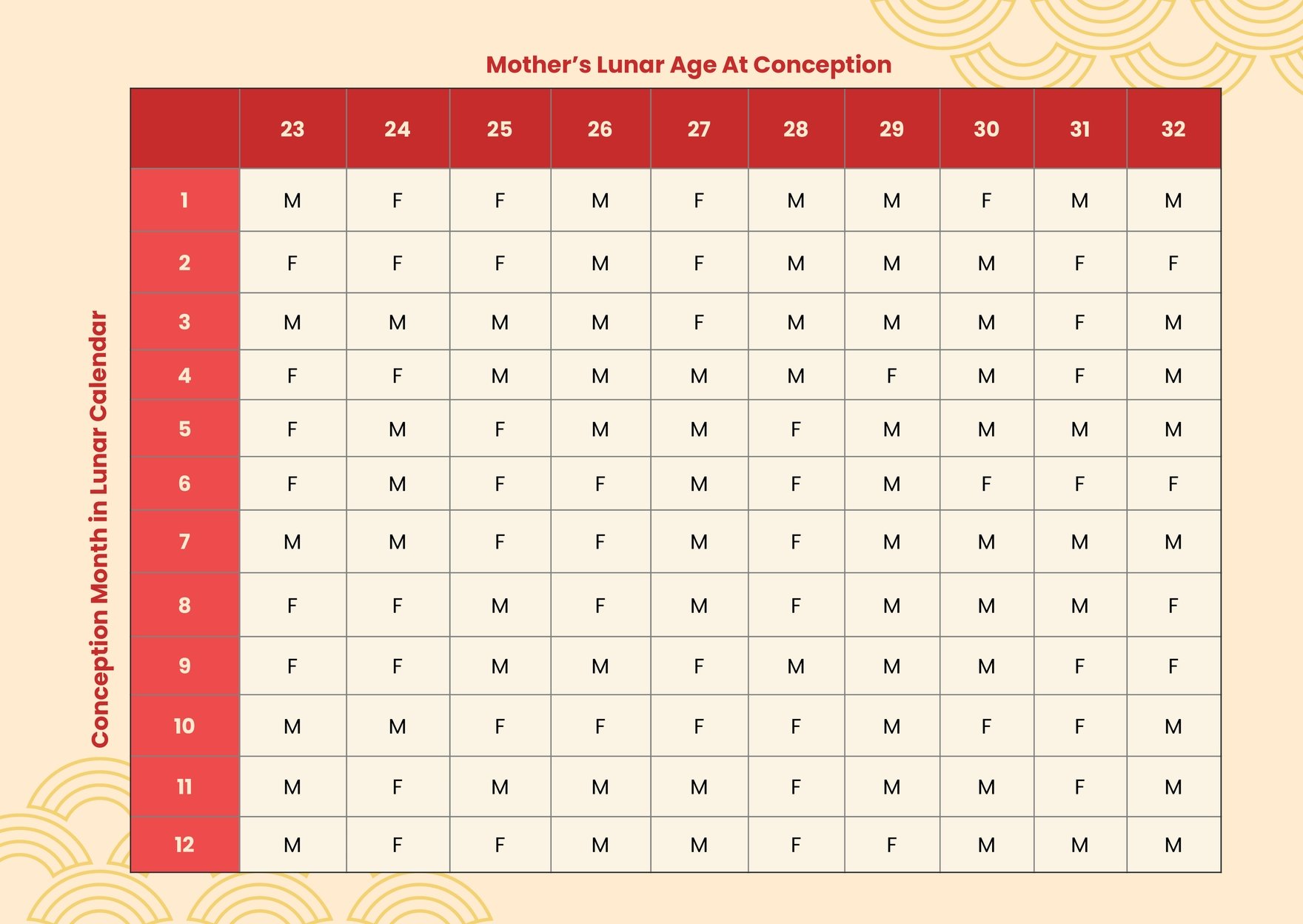For centuries, Chinese gender charts have fascinated people around the world with their claims of predicting a baby's gender based on lunar age and conception month. But why are there different versions of these charts, and how reliable are they? This article delves into the origins, variations, and significance of Chinese gender charts, offering a comprehensive guide to help you understand their purpose and limitations.
Chinese gender prediction charts have become increasingly popular in Western cultures, sparking curiosity among expectant parents. These charts are believed to have originated from ancient Chinese practices and have evolved over time, leading to various versions being used today. Understanding the differences between these charts can help demystify their purpose and historical context.
By exploring the historical background, scientific validity, and cultural significance of Chinese gender charts, we aim to provide a thorough analysis of why variations exist and what they mean for modern users. Whether you're simply curious or looking for answers, this article will equip you with the knowledge to navigate this intriguing topic.
Read also:Michigan State Tax Rate A Comprehensive Guide For Residents And Businesses
Table of Contents
- The History of Chinese Gender Charts
- Why Are There Different Versions?
- Understanding Lunar Age and Its Role
- The Scientific Validity of Chinese Gender Charts
- Cultural Significance and Traditions
- How People Use Chinese Gender Charts Today
- Modern Interpretations of Chinese Gender Charts
- Comparing Different Chinese Gender Charts
- How Accurate Are These Charts?
- Conclusion and Final Thoughts
The History of Chinese Gender Charts
Chinese gender prediction charts are believed to have originated during the Qing Dynasty, around 700 years ago. These charts were reportedly discovered in a royal tomb near Beijing and were used by ancient Chinese royalty to predict the gender of unborn children. The charts were based on the principles of Traditional Chinese Medicine (TCM) and astrology, which emphasize the balance of yin and yang energies.
Historical records suggest that these charts were used as part of a broader system of divination and astrology, which played a significant role in ancient Chinese society. The charts were designed to align with the lunar calendar, which was widely used in China for centuries. Over time, different regions developed their own versions of the charts, leading to the variations we see today.
Historical Context and Evolution
As Chinese culture spread across Asia, the gender prediction charts were adapted to fit local traditions and beliefs. For example, some versions incorporated elements of Feng Shui, while others focused more on numerology. This evolution resulted in multiple interpretations of the original charts, each with its own unique characteristics.
Today, these charts are often used as a fun tool rather than a serious method of gender prediction. However, their historical roots and cultural significance continue to intrigue people worldwide, making them a popular topic of discussion among expectant parents.
Why Are There Different Versions?
One of the most common questions about Chinese gender charts is why there are so many variations. The primary reason lies in the historical and cultural context of their development. Different regions in China had varying interpretations of the original chart, leading to slight differences in how lunar age and conception month were calculated.
Regional Differences in Chart Design
- Traditional Chinese Version: This version uses the lunar calendar and calculates age based on the Chinese zodiac.
- Taiwanese Adaptation: Incorporates elements of Feng Shui and focuses on the balance of yin and yang energies.
- Modern Western Interpretation: Simplifies the chart for easier use and often combines it with Western astrology.
These variations reflect the diverse ways in which Chinese culture has been interpreted and adapted over time. While the core principles remain the same, the specific details of each chart can differ significantly.
Read also:Monkey Band Members Exploring The Talent And Journey Of The Iconic Group
Understanding Lunar Age and Its Role
A key factor in Chinese gender charts is the concept of lunar age, which differs from the Western method of calculating age. Lunar age is based on the lunar calendar and begins at conception rather than birth. This means that a person's lunar age is typically one or two years older than their Western age.
To use a Chinese gender chart effectively, it's essential to calculate both the mother's lunar age at the time of conception and the month of conception according to the lunar calendar. This information is then matched to the chart to predict the baby's gender.
How to Calculate Lunar Age
Calculating lunar age requires converting your birth date to the lunar calendar and accounting for the difference in age calculation. While this may seem complicated, there are many online tools and apps available to help you determine your lunar age accurately.
The Scientific Validity of Chinese Gender Charts
Despite their popularity, Chinese gender charts have not been scientifically proven to accurately predict a baby's gender. Studies have shown that the accuracy of these charts is roughly 50%, which is no better than chance. However, many people still enjoy using them as a fun way to guess their baby's gender before an ultrasound confirms the result.
It's important to remember that these charts are rooted in ancient traditions and should be viewed as cultural artifacts rather than scientific tools. While they may not provide definitive answers, they can still be a source of entertainment and conversation for expectant parents.
Scientific Studies and Findings
Several studies have examined the accuracy of Chinese gender charts, with mixed results. A 2013 study published in the Journal of Reproductive Medicine found that the charts were slightly more accurate than random guessing, but the difference was not statistically significant. Another study conducted in 2015 by the University of California concluded that the charts were no better than flipping a coin when it came to predicting gender.
Cultural Significance and Traditions
Beyond their practical use, Chinese gender charts hold significant cultural importance in many parts of Asia. In traditional Chinese society, the birth of a boy was often considered more desirable due to the cultural emphasis on male heirs. Gender prediction charts were seen as a way to anticipate the gender of a child and prepare for its arrival accordingly.
Today, the cultural significance of these charts has shifted, and they are more commonly used as a fun tradition rather than a serious method of gender prediction. However, their historical roots and connection to ancient Chinese practices continue to make them a fascinating subject for study and discussion.
Modern Traditions and Adaptations
In recent years, Chinese gender charts have been adapted for use in various cultural contexts. For example, some couples in Western countries use them as part of baby showers or gender reveal parties, adding an element of surprise and tradition to these events. This blending of cultures highlights the universal appeal of these ancient charts and their continued relevance in modern times.
How People Use Chinese Gender Charts Today
While their accuracy may be questionable, Chinese gender charts remain a popular tool among expectant parents. Many people use them as a fun way to guess their baby's gender before an ultrasound confirms the result. Others view them as a way to connect with their cultural heritage and explore the traditions of their ancestors.
Some couples even incorporate Chinese gender charts into their baby naming process, using the predicted gender as inspiration for choosing a name. This creative approach reflects the versatility of these charts and their ability to adapt to modern needs and preferences.
Practical Tips for Using Chinese Gender Charts
- Calculate your lunar age and conception month accurately to ensure the best results.
- Use the chart as a fun activity rather than a definitive method of gender prediction.
- Combine the chart with other traditions or activities to enhance its cultural significance.
Modern Interpretations of Chinese Gender Charts
With the rise of technology and globalization, Chinese gender charts have undergone significant changes in recent years. Modern versions of the charts are often available online, making them more accessible to people around the world. These digital versions frequently include interactive features, allowing users to input their data and receive instant predictions.
Some modern interpretations of the charts incorporate elements of Western astrology, blending traditional Chinese practices with contemporary beliefs. This fusion of cultures has helped to popularize Chinese gender charts among younger generations who are interested in exploring both their roots and new ideas.
Online Tools and Resources
There are numerous online tools and resources available for those interested in using Chinese gender charts. These tools often provide detailed instructions, historical background, and cultural context to help users better understand the significance of these charts. Additionally, many websites offer printable versions of the charts for those who prefer a more traditional approach.
Comparing Different Chinese Gender Charts
With so many variations of Chinese gender charts available, it can be challenging to determine which one to use. To help you make an informed decision, we've compiled a comparison of the most popular versions:
- Traditional Chinese Version: Most accurate for those familiar with the lunar calendar and Chinese zodiac.
- Taiwanese Adaptation: Incorporates Feng Shui and yin-yang balance for a more holistic approach.
- Modern Western Interpretation: Simplified for ease of use and often combines with Western astrology.
Ultimately, the choice of which chart to use depends on your personal preferences and cultural background. Experimenting with different versions can help you find the one that resonates most with you.
Choosing the Right Chart for You
When selecting a Chinese gender chart, consider the following factors:
- Your familiarity with the lunar calendar and Chinese zodiac.
- Your interest in incorporating elements of Feng Shui or other cultural practices.
- Your preference for a traditional or modern approach to gender prediction.
How Accurate Are These Charts?
As mentioned earlier, the accuracy of Chinese gender charts is roughly 50%, which is no better than chance. While some people report success using these charts, it's important to approach them with realistic expectations. They should be viewed as a fun tool rather than a reliable method of gender prediction.
That said, many users find value in the cultural and historical significance of these charts, even if their accuracy is limited. For some, the process of calculating lunar age and conception month can be a meaningful way to connect with their heritage and prepare for the arrival of a new family member.
Real-Life Stories and Testimonials
Many people have shared their experiences with Chinese gender charts, offering a glimpse into how they are used in real life. Some users report surprising accuracy, while others acknowledge the charts' limitations. These stories highlight the diverse ways in which people engage with these ancient tools and the joy they bring to the experience of expecting a child.
Conclusion and Final Thoughts
In conclusion, the existence of different Chinese gender charts reflects the rich history and cultural diversity of this ancient practice. While their accuracy may be limited, these charts continue to captivate people around the world with their promise of insight into one of life's greatest mysteries. Whether you use them for entertainment, cultural connection, or both, Chinese gender charts offer a unique way to explore the traditions of the past while celebrating the joys of the present.
We invite you to share your thoughts and experiences with Chinese gender charts in the comments below. Do you have a favorite version or a memorable story to tell? Let us know, and don't forget to explore our other articles for more fascinating insights into the world of pregnancy and parenting.



